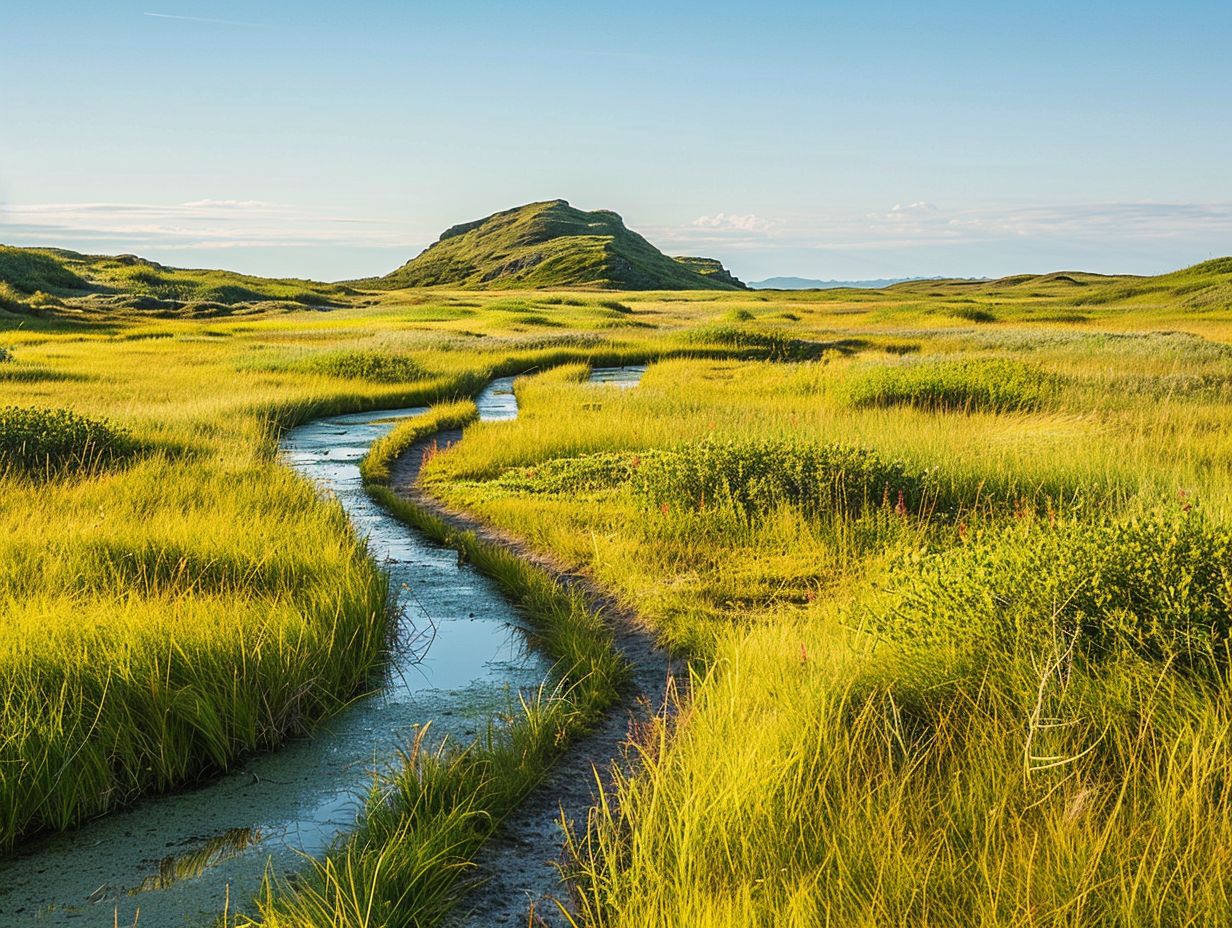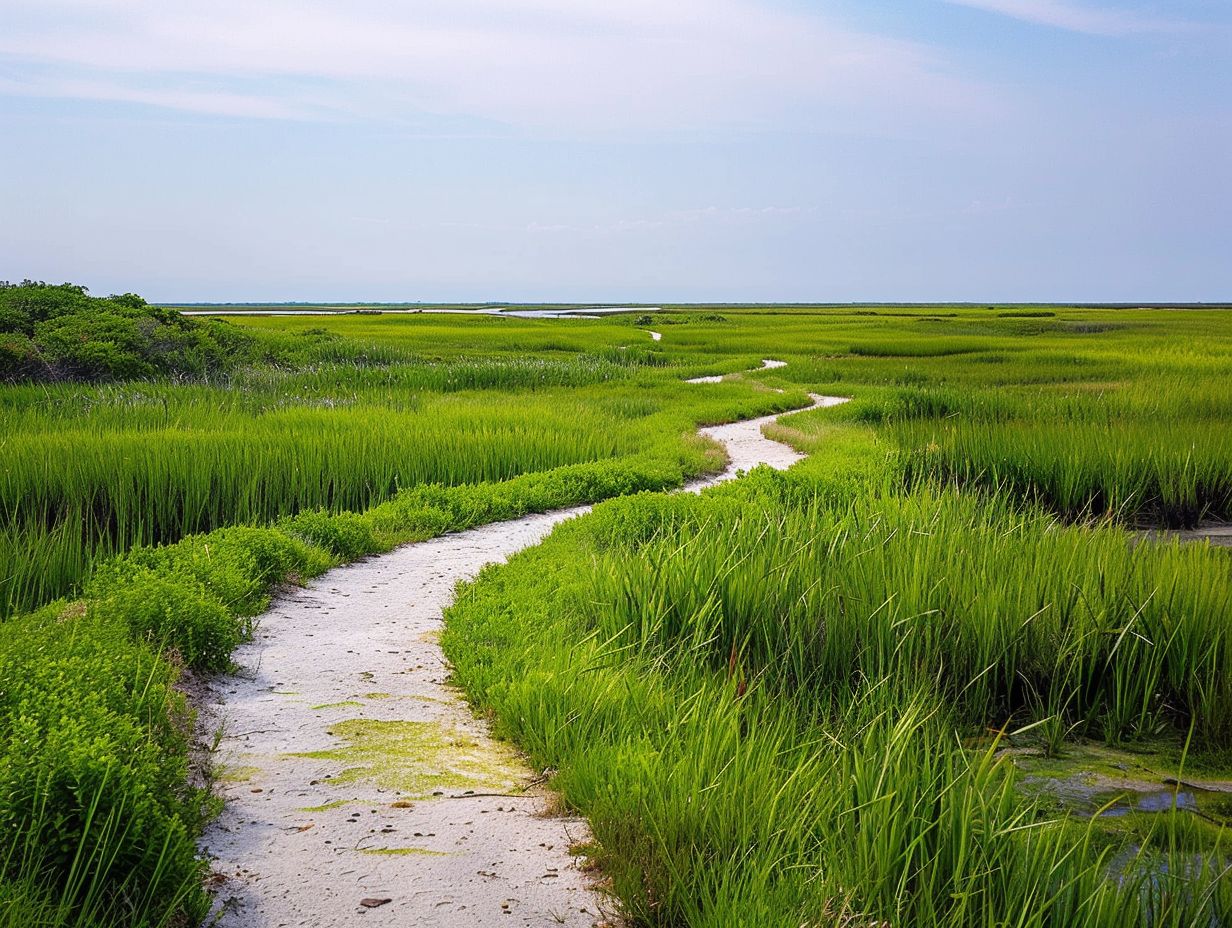Looking to explore the unique and beautiful marshlands of the UK?
We have compiled a list of the best hiking spots for experiencing marshlands, including the Broads National Park, Fens and Washes, Exmoor National Park, and more.
We will also provide you with essential items to bring on your marshland hike, as well as safety tips to ensure a memorable and safe outdoor adventure.
Lace up your boots, grab your gear, and get ready to discover the stunning marshlands of the UK!
Key Takeaways:

- The Broads National Park offers stunning views of marshlands and is home to a diverse range of wildlife.
- Proper footwear, insect repellent, and sun protection are essential items to bring on a marshland hike.
- When hiking in marshlands, be aware of tides, stick to designated paths, and watch out for wildlife. Be prepared for changing weather conditions as well.
What Are the Best Hiking Spots in the UK for Experiencing Marshlands?
Exploring the premier hiking locations in the United Kingdom renowned for their marshlands presents an exhilarating adventure. This endeavour provides a distinctive prospect to interact with a varied range of wildlife, delve into a heritage steeped in richness, and traverse scenic landscapes that are ideal for extended strolls and hikes.
1. The Broads National Park
The Broads National Park, situated across Norfolk and Suffolk, serves as a sanctuary for enthusiasts of nature, boasting an extensive network of waterways and abundant wildlife.
The exploration of The Broads presents visitors with an opportunity to fully immerse themselves in the serene beauty of the marshes, reedbeds, and wetlands that collectively form this exceptional landscape.
Birdwatchers are drawn to the park in pursuit of spotting rare species like bitterns, kingfishers, and marsh harriers. Furthermore, the area showcases a diverse array of plant species, encompassing exquisite water lilies and vibrant dragonflies.
Engaging in activities such as boating and canoeing along the peaceful waterways offers a tranquil means to appreciate the ecological importance and breathtaking environs of the park.
2. Fens and Washes
The Fens and Washes, located in Cambridgeshire and Lincolnshire, are widely recognised for their extensive wetlands and exceptional birdwatching opportunities. These wetlands present a remarkable exhibition of natural beauty, featuring vast marshes, reedbeds, and waterways that serve as a sanctuary for a diverse range of bird species.
Bird enthusiasts have the opportunity to observe migratory birds such as wigeons, teals, and pintails, as well as indigenous species like marsh harriers and bitterns.
The Fens and Washes play a pivotal role in conservation endeavours by providing essential habitats for both breeding and wintering birds. To optimise the birdwatching experience, it is highly advisable to visit during the migration seasons in spring and autumn.
3. Exmoor National Park
Exmoor National Park, situated across Somerset and Devon, presents a captivating amalgamation of moorlands, wooded valleys, and coastal cliffs, rendering it an ideal destination for hiking enthusiasts.
The park features a system of well-maintained hiking trails designed to accommodate individuals of all skill levels, ranging from leisurely excursions along the coastline to demanding expeditions across rugged moorlands.
Among these trails, the South West Coast Path stands as a prominent choice, offering awe-inspiring vistas of the Bristol Channel and the striking cliffs adorning the coast. For those with an interest in wildlife, Exmoor’s varied terrains serve as habitats to a diverse array of rare species, including wild ponies, red deer, and assorted birdlife.
Additionally, visitors have the opportunity to explore quaint villages, historic landmarks, and ancient woodlands dispersed throughout the park.
4. The New Forest National Park
The New Forest National Park in Hampshire is renowned for its ancient woodlands, open heathlands, and abundant wildlife, providing an array of trails suitable for hikers of varying skill levels.
The park boasts historical significance that dates back to the era of William the Conqueror, with remnants of ancient hunting grounds and medieval farming practices still discernible today.
Visitors have the opportunity to observe a diverse array of wildlife within the park’s ecosystem, including free-roaming ponies, deer, and rare bird species. For a fully immersive experience, embarking on trails like the Rhinefield Ornamental Drive or the Ober Water Trail allows nature enthusiasts to appreciate the park’s breathtaking landscapes.
Engaging in popular activities such as picnicking amidst the picturesque surroundings and wildlife observation contribute to creating memorable experiences within this conservation area.
5. The Peak District National Park

The Peak District National Park, located in Derbyshire, is renowned for its striking moorlands and picturesque limestone dales, providing a plethora of hiking trails suitable for individuals of all skill levels. These diverse terrains serve as a sanctuary for outdoor enthusiasts, drawing hikers from both local and distant regions.
Noteworthy geological formations, such as Stanage Edge and Winnats Pass, present endless opportunities for exploration amid remarkable rock structures and winding paths. Moreover, the park’s allure to hikers is bolstered by its rich ecosystems that undergo seasonal transformations, showcasing vibrant wildflowers during spring and transitioning to golden autumnal hues.
For those desiring a more tranquil hiking experience, visiting the park on weekdays or during the shoulder seasons can provide a serene ambiance amidst the awe-inspiring scenery.
6. The South Downs National Park
The South Downs National Park, renowned for its picturesque rolling chalk hills and breathtaking coastal views, sets a splendid stage for a variety of hiking excursions. Exploring the South Downs presents a blend of demanding hikes and relaxed strolls, catering to adept hikers and novices alike, all seeking outdoor pursuits.
Among the park’s well-frequented paths is the South Downs Way, a 100-mile stretch from Winchester to Eastbourne, boasting panoramic views en route. The park’s varied terrain, encompassing ancient woodlands, wildflower meadows, and expansive grasslands, establishes a sanctuary for wildlife enthusiasts and nature aficionados.
Equipped with clearly marked trails and charming village pubs, the South Downs National Park invites adventurers to fully immerse themselves in its natural splendour and rich historical legacy.
7. The North York Moors National Park
The North York Moors National Park is renowned for its extensive heather moorlands, ancient forests, and a plethora of trails that render it an ideal location for hiking.
Furthermore, alongside its exquisite heather moorlands and historical woodlands, the North York Moors feature a network of popular hiking trails that cater to hikers of all skill levels.
One of the most renowned routes is the Lyke Wake Walk, a demanding path that traverses the moors from Osmotherley to Ravenscar. For individuals seeking a more relaxed walking experience, the Rail Trail offers a scenic journey along a former railway track.
The optimal times to visit the North York Moors typically fall in late spring and early autumn when the heather blooms and the woodlands are adorned with vibrant hues.
What Should You Bring on a Marshland Hike?
The preparation for a marshland hike requires careful consideration of the equipment and supplies brought to ensure a safe and enjoyable walking experience.
1. Proper Footwear
Appropriate footwear is essential for traversing marshlands, given the wet and uneven nature of the terrain. Sturdy and waterproof hiking boots are recommended for such environments.
The significance of wearing the correct footwear extends beyond keeping one’s feet dry; it also provides crucial ankle support to mitigate injuries on challenging terrains.
For marshland exploration, it is advisable to select boots with high-traction soles to navigate slippery surfaces effectively. Boots constructed from waterproof materials like Gore-Tex are preferable to ensure dryness, even amidst muddy conditions.
Investing in high-quality hiking boots specifically tailored for marshland hiking can considerably enhance the outdoor experience by delivering both comfort and protection.
2. Insect Repellent
Insect repellent is a vital item to include in the packing list for a hike through marshes, as these environments are typically teeming with midges, ticks, and other biting insects. These insects not only cause a nuisance to hikers but also pose a risk of spreading diseases such as Lyme disease and West Nile fever.
Various types of insect repellents are available on the market, ranging from DEET-based sprays and picaridin formulas to natural alternatives like citronella oil. DEET is known for its high effectiveness against a wide range of insects and is particularly recommended for long excursions in heavily infested areas.
When applying insect repellent, it is advisable to cover exposed skin and clothing thoroughly. Moreover, to ensure continuous protection throughout the hike, it is crucial to reapply the repellent as directed on the product label.
3. Sun Protection

It is crucial to prioritise sun protection while embarking on a marshland walk, as the expansive landscapes can subject hikers to prolonged exposure to direct sunlight.
The application of sunscreen with a high Sun Protection Factor (SPF) serves the dual purpose of averting discomforting sunburns and diminishing the likelihood of skin cancer. Complementing sunscreen usage with the donning of a wide-brimmed hat can furnish additional protection to the facial area, neck, and ears.
Deliberately seeking shelter in shaded areas during the peak sun hours, typically spanning from 10 a.m. to 4 p.m., can mitigate the intensity of sun exposure. It is imperative to adhere to a sunscreen reapplication regimen every two hours, particularly following instances of swimming or perspiration.
By observing these measures, individuals can shield their skin from the adverse consequences of ultraviolet (UV) rays, thereby ensuring an enjoyable outdoor excursion.
4. Water and Snacks
It is imperative to ensure you bring an ample supply of water and snacks when embarking on a hike through a marshland to maintain proper hydration and sustain energy levels during the entirety of your journey. Opting for lightweight snacks that offer quick energy boosts, such as trail mix, granola bars, and fresh fruits, is highly advisable.
To facilitate ease of access, it is essential to pack these snacks in readily accessible containers, such as resealable bags or small Tupperware, in order to eliminate the need for unnecessary rummaging through your bag.
Additionally, integrating electrolyte-rich beverages or snacks into your provisions, such as coconut water or sports drinks, can aid in replenishing essential minerals lost through perspiration during the course of your hike.
It is paramount to schedule regular snack breaks to refuel and maintain consistent hydration by consuming water at regular intervals to prevent dehydration.
What Are Some Safety Tips for Hiking in Marshlands?
Engaging in hiking activities in marshlands can offer a safe and enriching experience when adhering to fundamental safety precautions and maintaining a keen awareness of the distinct challenges that these environments pose.
1. Be Aware of Tides
It is essential to consider the tides when engaging in hikes within marshlands, as the water levels have the potential to rise swiftly and unexpectedly, presenting a notable safety hazard. Ahead of commencing a hike, individuals are advised to consult tide schedules either online or through local resources.
Optimal timing for the hike is during low tide to facilitate a safe passage through areas that may become submerged during high tide. Risks associated with high tide include the possibility of being stranded on the return route, encountering deep water crossings, and becoming entrapped in marshy terrain.
To ensure personal safety, it is recommended to always carry a map and tide schedule, wear suitable footwear, and inform a friend or family member of the intended route and estimated time of return.
2. Stick to Designated Paths
Adhering to established paths is essential when crossing a marshland to ensure safety and reduce environmental damage. By sticking to the specified trails, individuals not only protect themselves from potential risks such as getting lost or encountering dangerous wildlife but also assist in the conservation of the sensitive ecosystem within the marshland.
Staying on the designated path reduces the risk of trampling on delicate vegetation and disturbing wildlife habitats. Furthermore, following the paths aids navigation, thus avoiding unintentional entry into dangerous or restricted areas.
Straying from the marked trails can lead to environmental harm, confusion, and possible encounters with wildlife that could endanger both personal safety and the integrity of the ecosystem.
3. Watch Out for Wildlife
It is essential to exercise caution when encountering wildlife during a hike in a marshland environment, as these areas serve as habitats for a diverse range of animals and birds that can be both captivating and potentially hazardous.
To safely observe wildlife, it is important to maintain a respectful distance and refrain from approaching or feeding the animals. If there is encountering potentially dangerous species such as alligators or snakes, it is advisable to remain composed and slowly retreat.
It is imperative to bear in mind that one is a visitor in their natural habitat and should avoid disrupting their natural behaviours or habitats. Marshlands serve as habitats for a variety of species including herons, frogs, and turtles, so it is crucial to be mindful of one’s impact and appreciate observing them from a distance.
4. Be Prepared for Changing Weather

It is vital to be prepared for changing weather conditions when undertaking a hike in marshlands, as these conditions have the potential to shift rapidly, impacting both safety and comfort. Ahead of embarking on a hike through marshlands, it is imperative to consult the weather forecast to anticipate any abrupt changes in temperature, wind speed, or precipitation.
Wearing clothing in layers enables hikers to readily adapt to fluctuating conditions, such as the transition from cool mornings to warmer afternoons. Bringing along appropriate gear, including a waterproof jacket, sturdy footwear, and a hat for sun protection, ensures that hikers are adequately equipped to manage unforeseen rain showers or intense sunlight.
By remaining well-informed and appropriately attired, hikers can derive enjoyment from their marshland excursion while prioritising safety and comfort.
Frequently Asked Questions
What are the best UK hikes for experiencing marshlands?
Some of the best hikes for experiencing marshlands in the UK include the Wicken Fen Nature Reserve in Cambridgeshire, the Severn Way in Gloucestershire, and the Broadland Trail in Norfolk.
Are these hikes suitable for beginners?
Yes, these hikes are suitable for beginners as they offer relatively flat terrain and well-marked trails. However, it is always recommended to research and prepare for any hike beforehand.
What can I expect to see on these hikes?
These hikes will take you through beautiful marshlands, where you can spot a variety of wildlife such as birds, amphibians, and insects. You may also see unique plant species and stunning landscapes.
When is the best time to go on these hikes?
The best time to go on these hikes is during the spring and summer months when the marshlands are in full bloom. This is also the best time to spot wildlife and experience the vibrant colors of the marshlands.
Do I need any special equipment for these hikes?
No, you do not need any special equipment for these hikes. However, it is recommended to wear appropriate hiking shoes and bring insect repellent, especially during the summer months.
Are there any guided tours available for these hikes?
Yes, there are guided tours available for these hikes, especially at the Wicken Fen Nature Reserve. These tours offer a more in-depth and educational experience of the marshlands and their inhabitants.

